Have you just strolled out of a garden center with a Peperomia puteolata in your hand, but have no idea how to care for it? We’ve all been there!
Peperomias especially seem to find their way into many plant lovers’ households these days.
With its attractive appearance and low maintenance, it is a great addition to your green collection.
Peperomia puteolata, also known as Parallel Peperomia, has bright veins running parallel to each other from the bottom to the top of its leaves.
Peperomia puteolata Care
To care for Peperomia puteolata provide a well-draining potting mix using one part perlite and one part peat moss. Provide bright indirect light and a temperature between 65-75°F (18-24°C). Water once the top 2” of soil are dry. An average humidity of around 40% is fine. Fertilize every 2-weeks in spring and summer with a liquid fertilizer at 1/2 strength.
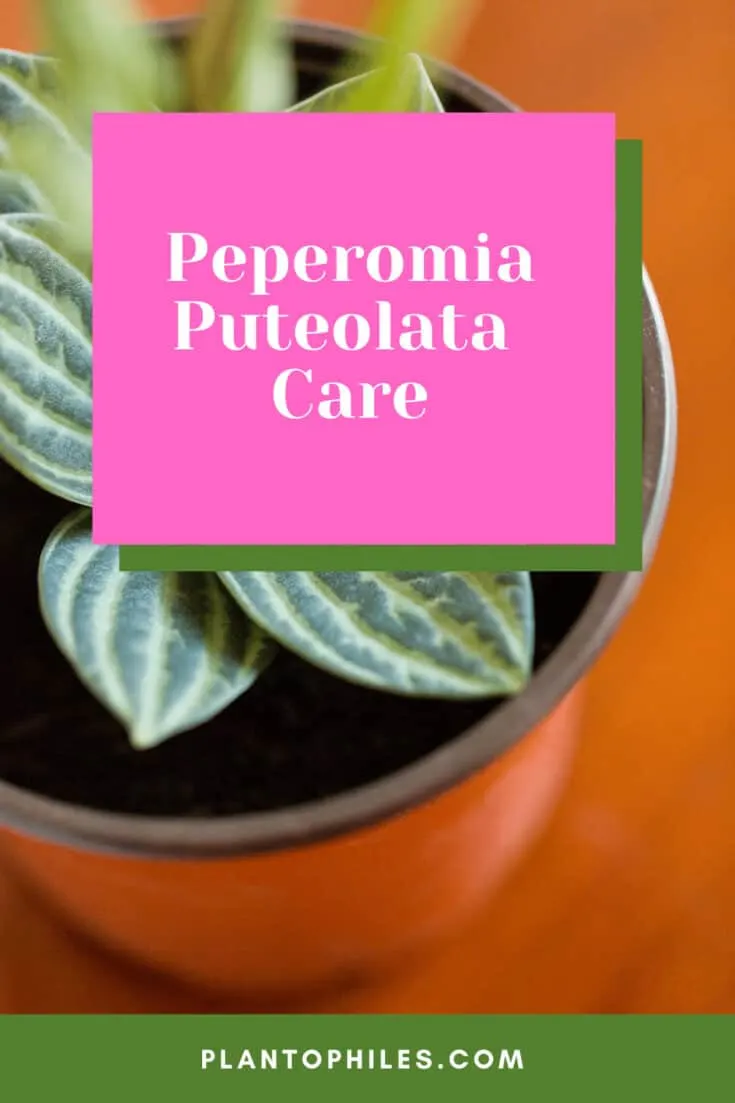
Table of Contents
Peperomia puteolata Care Tips
I would like to share with you some Peperomia puteolata care tips and tricks on how to keep your plant thriving.
Soil
Peperomia puteolata grows best in a well-draining mix consisting of one-part perlite with one-part peat moss.
Any houseplant enthusiast will agree with me when I say that good quality soil is one of the most important things you could provide for your plants to thrive.
One of the best practices you can adopt is mixing your own soil mixture.
Peperomia puteolatas originally grow in the dense and humid forest soil, the ones planted indoors though it will need good quality fast-draining soil, that will retain just the right amount of water.
To give your Peperomia puteolata the best care possible, you can mix one part perlite with one part peat moss, and make sure you don’t cover the drainage holes at the bottom of the pot completely.
That is important to avoid root rot, the most common and feared issue with houseplants.
Light
Peperomia puteolata grows best under bright indirect light.
Peperomia puteolata is not too picky with light, but you should bear in mind that good lighting will make the difference between a successful plant with vibrant colors that grow fast and one that just stagnates.
Peperomia puteolata is not a low light plant by any means, and they do enjoy a north or east-facing window that provides bright but indirect light.
Make sure it is not exposed to direct sunlight for extended periods of time, as this might irreparably damage the leaves.
It is normal, as a beginner, to struggle to find the right lighting for a plant in your home.
Besides researching and making sure you can provide the perfect conditions for a Peperomia puteolata before buying it, you can also move it around until you find the best place for it to grow.
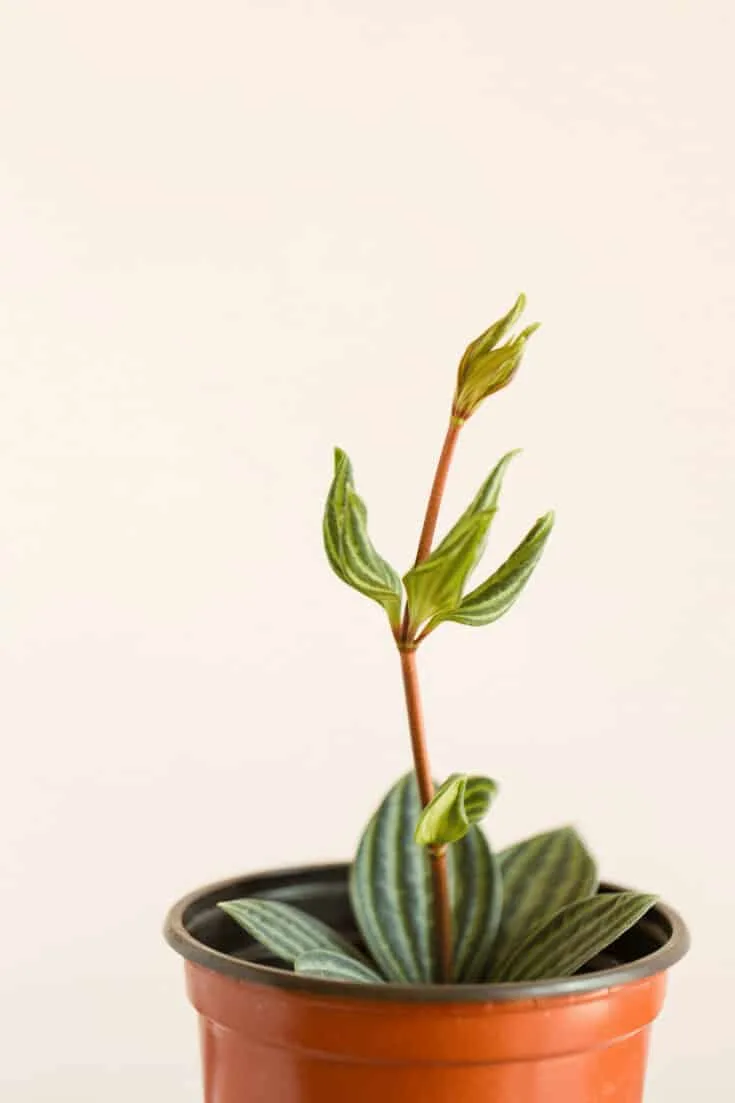
Provide bright indirect light for Peperomia puteolata
Watering
Water Peperomia puteolata once the top 2” of soil are dry.
Even if at first it doesn’t look like it, Peperomia puteolata is a semi-succulent plant.
That means that when you notice the soil is almost fully dry you should give it a good soaking.
Watering from the bottom is best, so you can take your pot (which should have drainage holes on the bottom) and dunk it in a container with water halfway up for about half an hour.
Let the roots absorb as much water as the plant needs, then take it out and let it drain.
Root rot due to over-watering is indeed the main culprit when your plant is in trouble.
Fortunately, your Peperomia puteolata will let you know when it is thirsty by drooping its leaves before it is too late.
When you do notice your plant wilting, soak it as soon as possible. Be sure to also water much less in the winter when the plant is dormant.
Another good tip would be to buy a moisture meter.
You stick the device in multiple places in the soil and read the measurement. If the soil is still moist, hold on the watering.
Temperature
Peperomia puteolata grows best at a temperature between 65° – 75° degrees Fahrenheit (18° C – 24° C).
As I have already mentioned, Peperomia puteolata is a tropical plant, so it needs a relatively warm environment to thrive.
It should be kept in temperatures between 65° – 75° degrees Fahrenheit (18° C – 24° C) and make sure it is not subject to any sudden temperature changes or drafts.
That can be avoided by not placing your Peperomia puteolata next to windows and doors, under AC vents, or in drafty parts of your home.
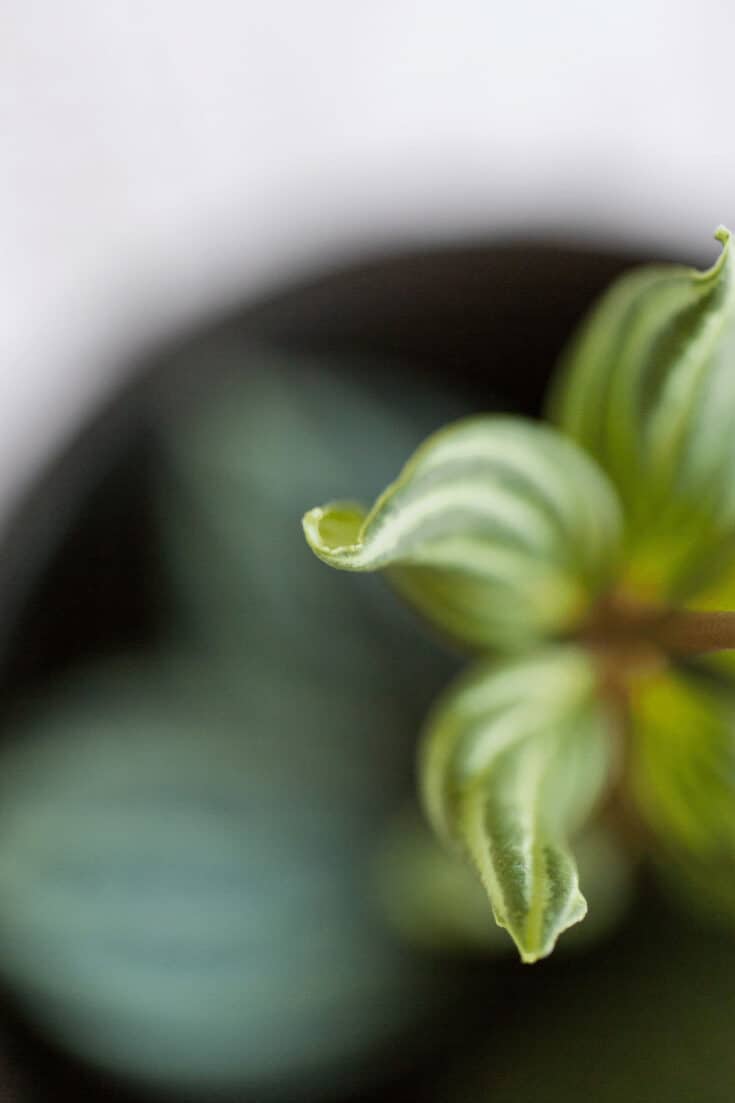
A temperature between 65-75°F (18-24°C) is optimal
Humidity
Peperomia puteolata grows just fine with average indoor humidity of around 40%.
But if you are like me and can barely keep the humidity in your space above 30%, I have some tips for you.Keep your plants in groups and as close together as possible.
That is not because they like to socialize, but because it is easier to elevate humidity with a few pots of soil grouped together.
You can also add a humidity mat, which is an easy and cheap way to increase humidity.
Use any shallow container, fill it with pebbles and water to a little bit below the brim and place your plant on top.
The water will gradually evaporate and give your plant a little bit more humidity.
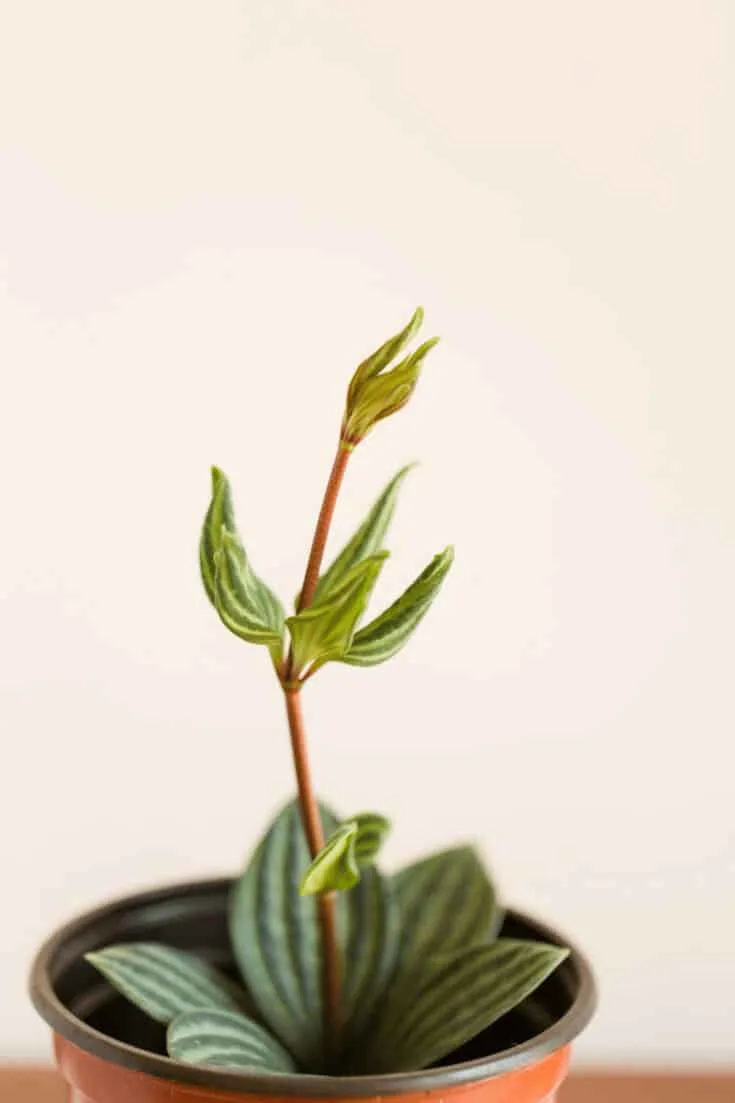
Average humidity around 40% is fine for this Peperomia
Fertilizer
Fertilize using a liquid fertilizer at 1/2 strength every two weeks in spring and summer.
I like to buy controlled-release pellet fertilizer to feed my Peperomia puteolata.
I chuck it in at the beginning of the growing season so I don’t have to worry about it.
Alternatively, you can mix a liquid fertilizer at half strength or less and add it to your watering regime every two weeks.
At the end of summer, when you notice colder temperatures and less sunlight, fertilizing is not necessary anymore.
Your Peperomia will be going dormant, so fertilizing at this time will damage the roots.
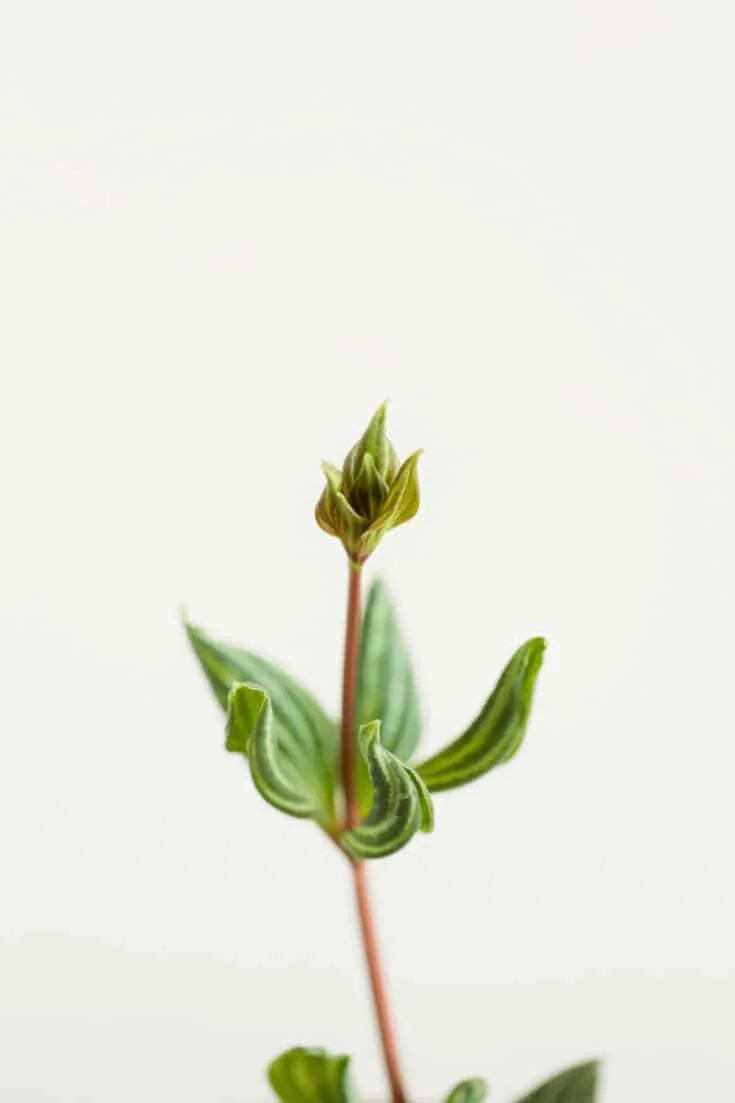
Peperomia puteolata is also known as Parallel Peperomia
Repotting
I repot my Peperomia puteolata only when I notice it has outgrown its pot.
You can check the bottom and see if any roots are peeking out of the drainage holes, as this is an indicator it’s a good time to give it a bigger container.
The best time to repot is in the spring so that the plant has a full growing season to get used to its new pot.
What kind of container you choose is also important, as you must pick a pot with big enough drainage holes to prevent stagnant water at the roots.
Propagation
I like to propagate my Peperomia puteolata by stem cuttings. This method showed the best results for me so far.
Below I compiled my full-proof step by step guide on propagating your Peperomia puteolata successfully:
1. Take a good look at your plant and chose your cuttings carefully. Make sure the mother plant will look good, even after you are done pruning. Pick healthy stems with no damage or pests. Those will be the foundation of a new plant, so you want to give them the best possible start.
2. Take a couple of cuttings and replant them in groups, so the new plant has a denser appearance and is not leggy.
3. Make sure your cuttings have at least a couple of nodes and two top leaves.
A node is the point where the leaves meet the stem and are usually a bit thicker than the rest of the stem.
That is where your roots will pop out. Keeping a couple of leaves is also crucial for the plant to keep on photosynthesizing and producing energy for new growth.
4. Remove the leaves from the bottom node and let the stem air dry for a couple of days. That will help you avoid root rot and give the plant a chance to heal the wounds you just made.
5. Prepare your soil and be mindful, rooting requires different soil then the mix your mother plant needs.
In order to grow roots, the cuttings need even moisture and a high quantity of nutrients. Ideally, mix one part soil and one part perlite.
6. Carefully, place your cuttings in the soil covering the nodes and keep them moist during the process.
You should also keep them in a warm and humid environment, which will promote faster rooting.
7. Once you notice new growth on the plant and you think the roots are established enough you can repot it into the peat and perlite mix I mentioned before.
Growth
These plants usually stay small. Although they grow upright they tend to develop more sideways in a trailing manner.
You can keep it in the desired size by regularly pruning it.
Common pests
Peperomia puteolata is usually trouble-free but it can attract the usual pests we find on our houseplants.
It is important to separate the infested plant from the other ones as soon as you can, to avoid the pests spreading to all the other plants.
When you notice any crawlies chances are it’s one of these three.
Whiteflies: If you notice small fruit fly-like white bugs around your Peperomia puteolata, it’s probably whiteflies.
These also feed on your plant’s juice and cause wilting and yellowing of the leaves.
The best course of action, in my experience, is spraying the whole plant with a solution of water and dish soap, making sure you are removing all of the larvae and eggs, and then treating the plant with neem oil regularly.
Neem oil is a non-toxic vegetable oil that acts as a feeding deterrent for pests.
Mealybugs: If you notice small fuzzy bugs at the bottom of your Peperomia puteolata leaves or stems, those are mealybugs.
They damage the plant by sucking its juice. You can remove them manually with cotton buds soaked in a water and isopropyl alcohol solution with a ratio of 10:1.
This process will have to be repeated quite a few times before you get rid of them.
Spider mites: One of the hardest to get rid of in my experience, spider mites are also small white spider looking bugs that create webs on your plants.
They multiply fast and can do a lot of damage. The only full-proof way I found to get rid of those long term, apart from insecticides, is changing the environment of my plant.
Spider mites love a dry and hot environment, so upping the humidity in the area will deter them.
I usually move the infected plant into my bathroom for quarantine where the bugs just give up and die off.
Peperomia puteolata
The leaves are a cold-toned, dark green with red-tinted stems.
The beautiful ornamental foliage offers an aesthetic similar to variegated plants but with less maintenance.
I love to place them on coffee tables, nightstands, or office desks where they can trail while not occupying much vertical space.
This plant does flower occasionally but the flowers are not attractive and can be cut off.
So where does it come from and how do you master Peperomia puteolata care?
It is native to South America where you can find them trailing the tropical forest ground, reaching upright to catch some sun rays.
Although the conditions there are much different than in most homes, Peperomias are pretty tolerant and beginner-friendly plants.
Commonly asked questions about Peperomia puteolata care
Why is my Peperomia Puteolata dropping leaves?
If the soil is very dry you can try thoroughly watering as described in my post earlier.
If this is not the case, and you have been watering regularly, the first thing you should do is let the soil dry out and then take the plant out of its pot to check the roots.
The roots should be white and healthy-looking, with no browning or rot.
Why is my Peperomia Puteolata wilting?
If the soil is very dry you can try thoroughly watering as described in my post earlier.
If this is not the case, and you have been watering regularly, the first thing you should do is let the soil dry out and then take the plant out of its pot to check the roots.
The roots should be white and healthy-looking, with no browning or rot.
My Peperomia has root rot. Now what?
Do not despair. Take your plant out of the container and free the roots of all soil.
Now carefully cut away all the rotting roots and run the plant under some tepid water to wash away any mold or fungus.
You should be left with all-white, clean, and healthy roots that can be repotted in new soil.
What insecticide can I use to get rid of pests on my Peperomia Puteolata?
I’m usually not keen on insecticides and never recommend them, especially if you have children or pets in your home.
I would get rid of any pests by first showering the plant and manually removing any bugs I find. I then spray the whole plant thoroughly with neem oil and keep on treating it this way until the plant is pest-free.
Neem oil is a non-toxic vegetable oil commonly used to deal with different pests on houseplants.
It doesn’t contain any harmful substances and is also a great preventative measure against mold and fungus.
Since it doesn’t kill the bugs on contact, it has to be re-applied regularly.
How can I increase the chances of my cuttings rooting?
If you are in a rush or want to increase your chances of success you can dip the bottom of the cuttings in a growth hormone mixture.
This can be bought in most gardening stores.
Can I propagate my Peperomia Puteolata by water?
Water propagation is an option but the cuttings are usually small and flimsy, so if you choose to go that way make sure you have small enough containers that will accommodate the cutting.
This could be some kind of test tube or another container with a narrow opening.
The problem you might run into here is that it takes some time for the roots of a cutting to get used to the soil after growing in water.
Conclusion About Peperomia puteolata
To conclude, Peperomia puteolatas are low maintenance, beautiful plants, that will undoubtedly enhance the look of any space in your home.
I would encourage any beginner to try their hand at caring for a Peperomia puteolata, as they return all of your efforts with eye-catching foliage and will not discourage you on your houseplant collection journey.

Daniel has been a plant enthusiast for over 20 years. He owns hundreds of houseplants and prepares for the chili growing seasons yearly with great anticipation. His favorite plants are plant species in the Araceae family, such as Monstera, Philodendron, and Anthurium. He also loves gardening and is growing hot peppers, tomatoes, and many more vegetables.


